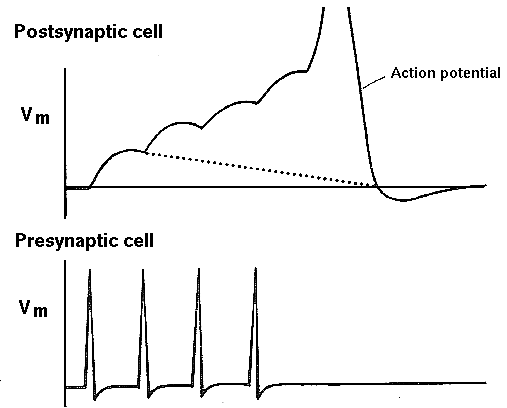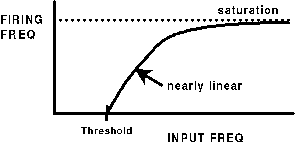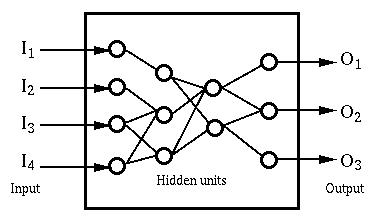A summary of methods used for simplified neuronal models
Overview of artificial neural networks
The goal of this short summary is to explain the neurobiological basis
of ANN models by identifing the characteristics of biological neurons and
neural networks that should go into a simple model of what we might call
"biologically-inspired computation".
Properties of "wet" neurons
What do we know about the behavior of real neurons that we would like
to include in our model?
- Neurons are integrating (summing) devices. Each input spike causes
a PSP which adds to the charge on the membrane capacitance, gradually
increasing the membrane potential until the potential in the axon
hillock reaches the threshold for firing an action potential.

- Neurons receive both excitatory and inhibitory inputs, with
differing and modifiable synaptic weights. This weighting of synaptic
inputs can be accomplished in a variety of ways. The efficiency of a
single synaptic connection depends on the surface area and geometry of
the synapse and the number of vesicles containing neurotransmitter on
the presynaptic side. A neuron which interacts strongly with another
may make many synapses with the same target neuron, so we can use
multiple synapses to increase the weight of a connection between two
neurons.
- Neurons have a non-linear input/output relationship.
Input Output
|_______|_______|_______|_______| ________________________________
|___|___|___|___|___|___|___|___| |_______|_______|_______|_______|
|_|_|_|_|_|_|_|_|_|_|_|_|_|_|_|_| |_|_|_|_|_|_|_|_|_|_|_|_|_|_|_|_|
||||||||||||||||||||||||||||||||| |_|_|_|_|_|_|_|_|_|_|_|_|_|_|_|_|
Do you remember why this is so?
If we plot the input firing rate vs. the output firing rate, we
generally get something like this, with a threshold, and a
saturation level arising from the refractory period for firing.

The generic model "neuron"
There are many variations on the models which have been proposed for
artificial neuron-like computational units. Other lectures in this course
will cover some of them in detail, and a few of them superficially. Most
of them have these basic features.
- The output of the ith neuron is represented by a voltage level,
Vi,
instead of a sequence of spikes. Sometimes this is a continously
variable analog voltage, which represents the firing rate of a real
neuron. In other models, the output is a binary value, representing
either firing or not firing.
- The input to the ith neuron is a weighted sum of the outputs of
the neurons that make connections to it, plus any external inputs. The
connection weights, Wij, may be positive or negative, representing
excitatory or inhibitory inputs.

- The output is related to the input by some non-linear function
Vi = f(ui), which may look like:

The function often has some sort of threshold parameter (theta) that
allows different neurons to have different thresholds for activation.
We'll see different variations on this basic paradigm. Almost all of
them have in common the idea that the so-called "neurons" receive
inputs from the outside world, or from other neurons, which are
multiplied by some weighting factor and summed. The output or
"activation" is formed by passing the input through some sort of
"squashing" function. This output often becomes the input to other
neurons.
The situation we are describing is something like this,

with some units ("neurons") receiving external inputs (I), some
presenting an external output (O), and others being intermediate (hidden)
units that only connect with other units. The output of one unit is passed
on to become part of the weighted input of another, finally reaching the
output units. The states of the neurons may be updated in parallel
(synchronously), or one at a time (asynchronously). In most neural network
models, the network is designed so that the outputs of all the neurons will
eventually settle down to a steady state when the external input is held
constant. It may take a number of iterations of the update process for
this to occur. (Biological networks are different in this respect - their
output is usually continously changing.) Various learning algorithms such
as "backpropagation" are used to modify the weights in order train the
network to perform some mapping between inputs and outputs.
A question to discuss: What possibly significant features have we left
out of our model? Are there any important ways in which it is
different from real neurons?
Spatial effects - What are the consequences of having inputs to
various parts of an extended dendritic tree? Can the right weights in a
ANN model take this into account? Perhaps not. For example, shunting
inhibition by the activation of channels close to the soma can "gate"
excitation from more distant regions. The various ways that that
computations are performed in the dendritic tree is a current research
topic.
Temporal effects - is firing rate everything? Our artifical
neurons have an output which either corresponds to a firing rate or
simply to "firing" or "not firing". However, the pattern of firing of
a biological neuron can encode information. The phase relationship
and correlations between the firing of neurons can be important. If a
neuron receives input from several others that are firing in unison,
the effect will be larger than if their firings were uncorrelated.
There may be even more subtle ways that the spacing of action
potentials can convey information. Consider the differences between
the firing patterns of neurons A, B, and C, which all have the same
average firing rate:
A |___|___|___|___|___|___|___|___|
B __|___|___|___|___|___|___|___|__
C |||_________|||_________|||______
If another neuron receives synaptic inputs from neurons A, B, or
C, can you see how the results might vary?
Here are some specific examples:
- As little as three spikes from the retinal system of the blowfly
can tell it which way to turn. Obviously, many bits
of information would be required for any sort of precision. This
implies that analog information conveyed by spike timing is being used.
- The barn owl uses phase differences and delays for sound
localization.
- In the cat visual system, spike timing is preserved through four
layers of the visual cortex - there must be a reason for this.
- Spiral ganglion cells in the cochlea phase lock when stimulated by
pure tones.
For some rather outdated lecture notes on AI and Artificial Neural Nets
from a University of Colorado web site, see:
Computer
models of mind and brain - Artificial Intelligence and
Lectures on Artificial Neural
Networks.
Simplified Integrate-and-Fire Models
In order to provide more realistic neurons than those used in
non-spiking artificial neural nets, Integrate-and-Fire neuron models are
often used in simplified network models. As illustrated below, they are
point neurons with no dendritic structure or ion channels. They simply sum
post-synaptic potentials as if charging the membrane capacitance and fire a
spike when a threshold is exceeded. The models typically used for the
synaptic inputs range from simple current injection pulses to the realistic
synaptically activated conductance models used in GENESIS and other
biologically realistic neural simulators.
|
Integrate-and-Fire neuron
if V < Vthresh, then V = IR[1 - exp(-t/RC)]
else generate a spike and set V = Vrest
|

|
Network of Integrate-and-Fire neurons
- 75% excitatory (red)
- 25% inhibitory (blue)
- Sparse random connectivity
|

|
The computational efficiency of this simple model makes it possible to
rapidly simulate networks such as the one illustrated above.
Special-purpose simulators for integrate-and-fire networks can easily
simulate networks with hundreds of thousands of neurons.
 Back to
Realistic Neural Modeling with GENESIS
Back to
Realistic Neural Modeling with GENESIS







 Back to
Realistic Neural Modeling with GENESIS
Back to
Realistic Neural Modeling with GENESIS